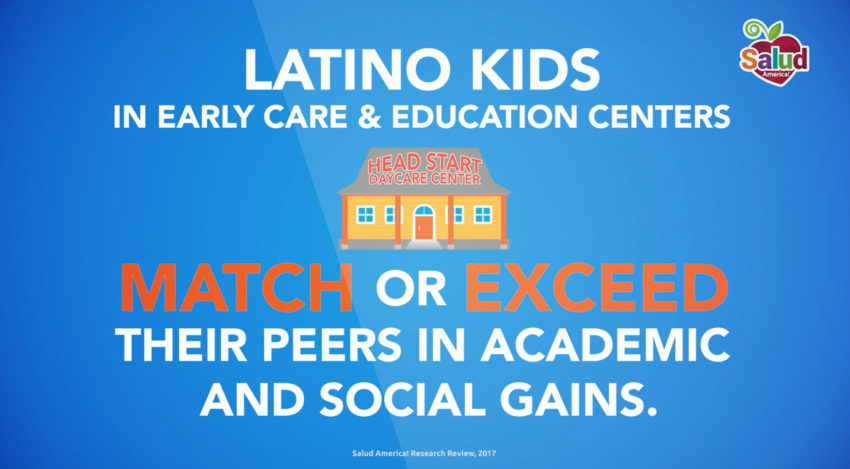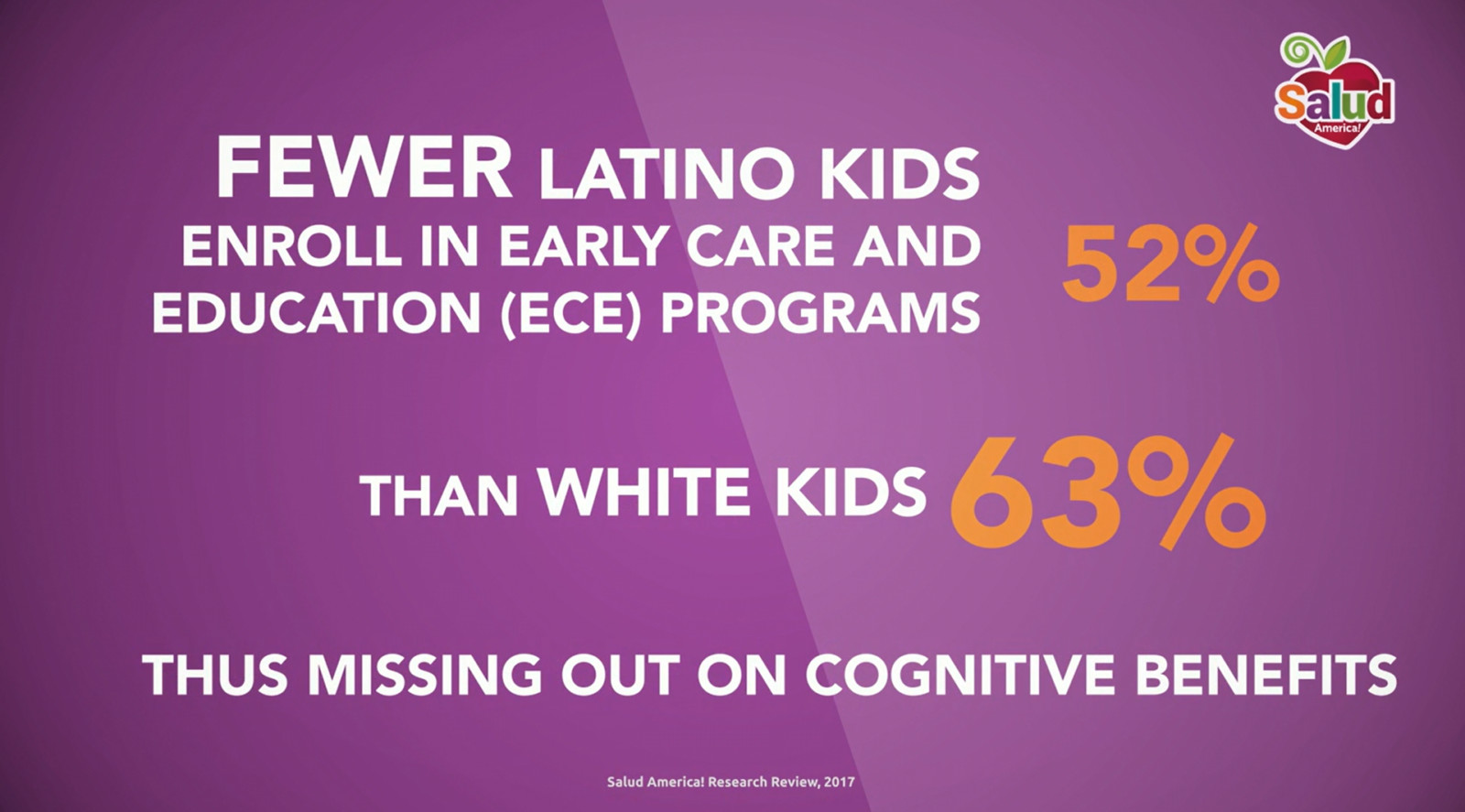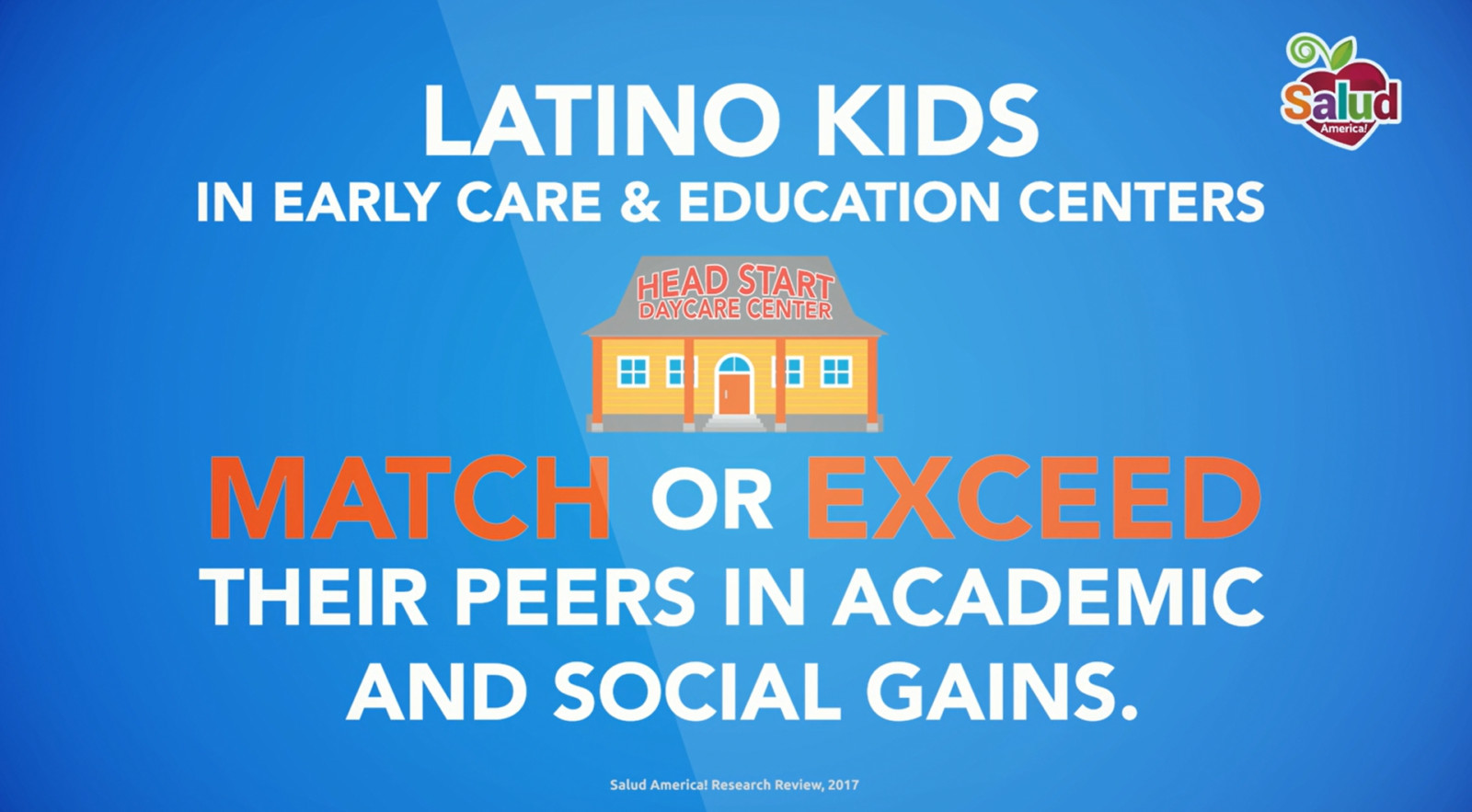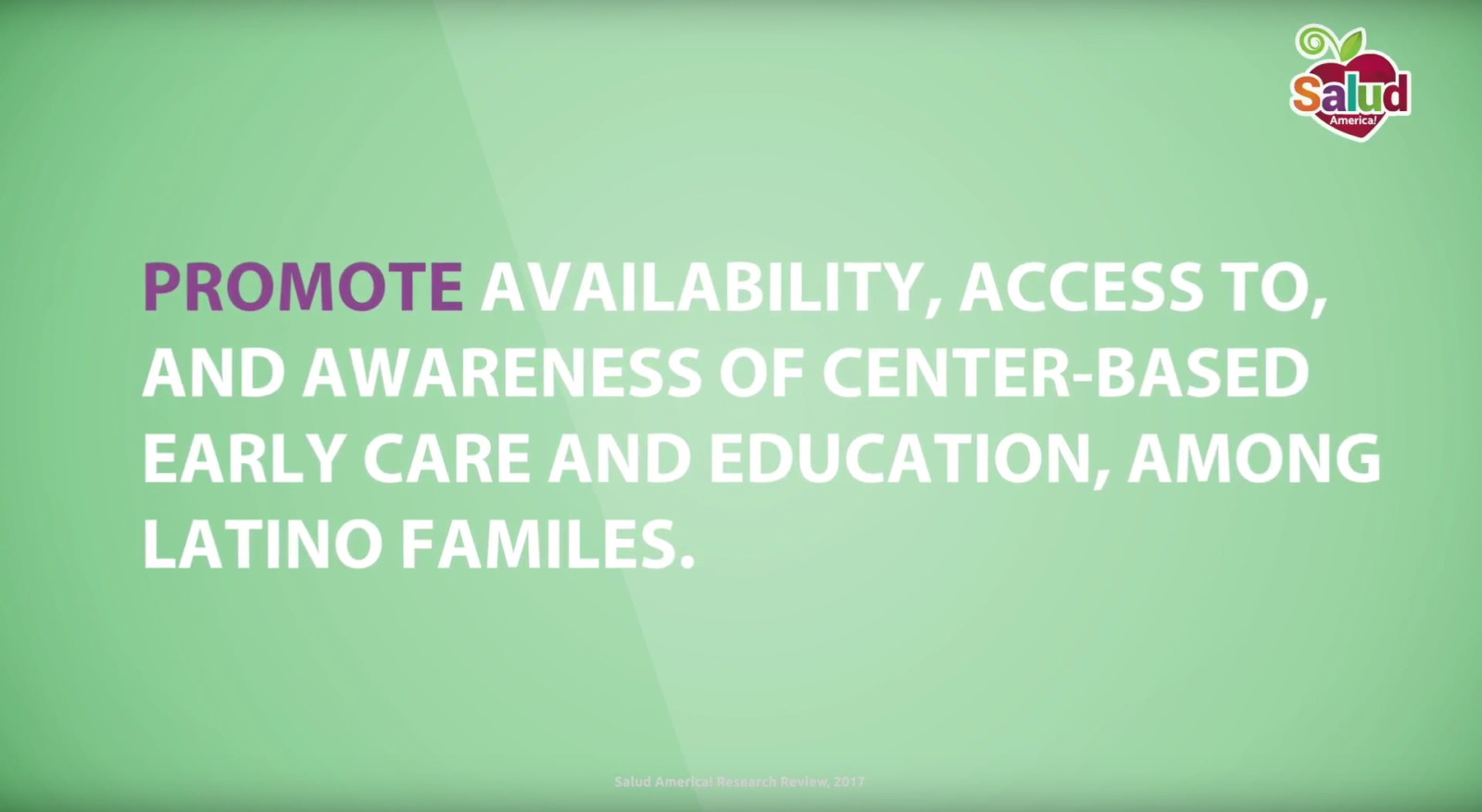
Share On Social!
This is part of our Building Support for Latino Families: A Research Review »
Latino Kids Less Likely to Use ECE Programs
The use of ECE facilities—including child care centers, day care homes, Head Start programs, preschool and pre-kindergarten programs—has become the norm in the U.S.38 About 61% of children younger than 6 are in a non-parental care arrangement on a weekly basis.38
 In 2012, children from higher-income families tended to enroll more in ECE centers (72%) than children from low-income families (45%), 2016 data show.1
In 2012, children from higher-income families tended to enroll more in ECE centers (72%) than children from low-income families (45%), 2016 data show.1
In addition, far fewer Latino children (52%) were enrolled in ECE centers than their white (63%), black (68%), and Asian peers (68%).1,39
ECE Programs Stimulate Cognitive Health Benefits
However, recent research has demonstrated that early childhood intervention can stop the cycle of academic and social disadvantage.
Children who participate in high-quality early care and education (ECE) programs experience a range of immediate and long-term cognitive and health benefits, with the greatest impact seen in low-income populations.9–11,28,40
In particular, center-based ECE, as opposed to family-based childcare, has been shown to impart maximal benefit. Center-based ECE generally involves a separate building organized into classrooms, where larger numbers of children attend. These can be for-profit, not-for-profit, church-based, or federally funded programs.27
High-quality ECE centers have several characteristics in common: well-trained and supported teachers, low student-to-teacher ratios, early learning curricula and assessments that measure the child’s academic, social-emotional, and physical progress, support for English learners and students with special needs, and a well-implemented state quality rating.41 In addition, the inclusion of meaningful family engagement has been shown to result in even greater impacts, and will be discussed below.
Latino Kids Have Positive Gains in ECE Programs
 When Latino children are enrolled in such center-based ECE, they achieve academic and social gains on par with, or even greater than, their non-Latino peers.31,42–44
When Latino children are enrolled in such center-based ECE, they achieve academic and social gains on par with, or even greater than, their non-Latino peers.31,42–44
However, many studies have shown that low-income Latino parents less frequently access center-based childhood education services than other low-income populations.45–47
The cause for this discrepancy is discussed below.
Addressing the needs of individual Latino communities to increase access to high-quality center-based ECE may be pivotal to ensure the success of Latino children in the United States. There are communities that may require changes in affordability (number of subsidized slots per site, etc.), while others may require changes in transport arrangements and physical access, as discussed below. Demographic studies of specific Latino populations within the United States may prove beneficial to allow policymakers to determine the requirements of particular communities, and how to best serve the needs of Latino children and families across our nation.
Therefore, policies that specifically encourage Latino families to enroll their children in center-based child care, while simultaneously providing parents with access to resources that limit their time in poverty, may help Latino families best support their child’s developmental needs.
The Myth that Latinos Prefer Home-Based Childcare
Trends in early childcare and education within the Latino community have been changing over the past 40 years.
Many factors play a role in Latino families’ choice of child care, including socioeconomic status, family structure, employment hours, language barriers, and community characteristics such as the availability and range of options for care.13,48–52
In the past, researchers had suggested that cultural preferences for maternal-like care, such as informal arrangements with family members, friends, and neighbors, were responsible for lower rates of center-based ECE use in Latino communities.53–55
However, causal evidence for this stereotype is limited.56,57
More recent research based on analysis of 2012 National Survey of Early Care and Education (NSECE) data finds equivalent patterns of home- and center- based care for low-income Latino children and children from low-income white and black households.52 Furthermore, when asked directly about their perceptions and preferences for child care arrangements, Latino parents rate center-based care similarly to their white and black peers.13 Latino parents were, however, less likely than their peers to label center-based care “affordable.”13 Interestingly, one study based on data from the Survey of Income and Program Participation (SIPP) Child Care Survey (US Census Bureau 2011) reported that Latinos utilized organized care centers half as much as their non-Latino white peers, with the notable exception of Head Start programs.55 These findings are important since they suggest there would be high uptake of center-based care within Latino communities if it were made affordable and accessible.
Barriers to Latino Participation in ECE Programs
A deeper understanding of the barriers to ECE center use within Latino communities sheds light upon changes that need to be made.
Many studies confirm that for Latinos, affordability and accessibility (both the physical location, as well as transport to that location) are the primary determinants of ECE program uptake.57–59
In neighborhoods with plentiful center-based child care slots, both English and non-English speaking families are more likely to choose these options.58–60
Use may be contingent upon increases in federal funding for childcare accessible to low-income families. Latino families living in communities with a greater number of designated seats for low-income children within high-quality ECE centers preferentially use these centers over informal care.34,60 Using data from 5 cities in the United States, Fuller and colleagues34 found that city of residence was a better predictor of high-quality ECE use than any maternal characteristic (e.g. ethnicity, English language skill, age, education, occupation), indicating wide variability in the availability of ECE centers across the country.
Perhaps most importantly, parents must be made aware of the existence of and their eligibility for these ECE centers.
In a study of factors that impact ECE participation of children of immigrants, three key factors were identified: accessibility, awareness, and responsiveness.47 So not only may ECE programs be unavailable or unaffordable in certain communities (accessibility), but if they are available, families may not be aware of their services (awareness), or the programs may not be responsive to the linguistic and cultural needs of the community (responsiveness).61
As such, policymakers must be cognizant of differences between subcommunities when designing ECE programs for Latino populations.
How to Spark Latino Participation in ECE Programs
 Thus, policies and programs that could directly benefit Latino families include:
Thus, policies and programs that could directly benefit Latino families include:
- Expansion of universal pre-K initiatives, particularly if they include 3- and 4-year-olds
- Expansion of Head Start and Early Head Start Programs to include a greater number of Latino communities
- Expansion of care in these programs during non-standard hours
- Increased funding for low-income students in these programs
- Increased funding for dual language teachers and students within these programs
- Increased public-private partnerships to finance early education programs
- Spanish-language ads—in print, radio, TV, digital—that inform Latinos of the availability of these programs in their communities
Increasing the availability, affordability, physical access, and awareness of center-based ECE would help improve the development of Latino children and families in the United States.
Further research will need to determine whether families just above the poverty threshold would be left behind if subsidized slots serve as the main access point into these programs for the majority of Latino families.
More from our Building Support for Latino Families: A Research Review »
- Introduction & Methods
- Key Research Finding: Latinos’ Big Healthcare Gaps
- Key Research Finding: Early Cognitive Development
- Key Research Finding: ECE Programs (this section)
- Key Research Finding: Disconnected Latino Parents
- Key Research Finding: Head Start Centers as Resource Hubs
- Key Research Finding: Promotores de Salud
- Key Research Finding: Latino Medical Homes
- Key Research Finding: Latino Community Schools
- Policy Implications
- Future Research Needs
References for this section »
1. Federal Interagency Forum on Child and Family Statistics. America’s children: Key national indicators of well-being, 2015. (Government Printing Office, 2015).
9. Campbell, F. et al. Early Childhood Investments Substantially Boost Adult Health. Science 343, 1478–1485 (2014).
10. Barnett, W. S. Effectiveness of Early Educational Intervention. Science 333, 975–978 (2011).
11. Karoly, L. A., Kilburn, M. R. & Cannon, J. S. Early childhood interventions: proven results, future promise. (Rand, 2005).
13. Guzman, L., Hickman, S., Turner, K. & Gennetian, L. Hispanic Children’s Participation in Early Care and Education: Parents’ Perceptions of Care Arrangements, and Relatives’ Availability to Provide Care. (2016).
27. Ansari, A. & Winsler, A. School readiness among low-income, Latino children attending family childcare versus centre-based care. Early Child Dev. Care 182, 1465–1485 (2012).
28. Chernoff, J. J., Flanagan, K. D., McPhee, C. & Park, J. Preschool: First Findings from the Preschool Follow-Up of the Early Childhood Longitudinal Study, Birth Cohort (ECLS-B). First Look. NCES 2008-025. Natl. Cent. Educ. Stat. (2007).
31. Ansari, A. & López, M. Preparing low-income Latino children for kindergarten and beyond: How children in Miami’s publicly-funded preschool programs fare. children 7, 9 (2015).
34. Fuller, B., Kagan, S. L., Loeb, S. & Chang, Y.-W. Child care quality: centers and home settings that serve poor families. Early Child. Res. Q. 19, 505–527 (2004).
38. National Center for Education Statistics. Early Childhood Program Participation Survey of the National Household Education Surveys Program (ECPP-NHES:2005). (2005). Available at: https://nces.ed.gov/programs/digest/d09/tables/dt09_044.asp. (Accessed: 1st August 2017)
39. Federal Interagency Forum on Child and Family Statistics. America’s Children in Brief: Key National Indicators of Well-Being, 2017. (2017).
40. Muennig, P. et al. The effect of an early education program on adult health: the Carolina Abecedarian Project randomized controlled trial. Am. J. Public Health 101, 512–516 (2011).
41. Wechsler, M., Melnick, H., Maier, A. & Bishop, J. The building blocks of high-quality early childhood education programs. Palo Alto Learn. Policy Inst. (2016).
42. Bridges, M., Fuller, B., Rumberger, R. & Tran, L. Preschool for California’s Children: Promising Benefits, Unequal Access. Policy Brief 04-3. Policy Anal. Calif. Educ. PACE NJ1 (2004).
43. Gormley, W. T. & Phillips, D. The Effects of Universal Pre-K in Oklahoma: Research Highlights and Policy Implications. Policy Stud. J. 33, 65–82 (2005).
44. Loeb, S., Bridges, M., Bassok, D., Fuller, B. & Rumberger, R. W. How much is too much? The influence of preschool centers on children’s social and cognitive development. Econ. Educ. Rev. 26, 52–66 (2007).
45. Child Trends Databank. Preschool and prekindergarten: Indicators of Child and Youth Well-Being. (Child Trends, 2015).
46. Mamedova, S. & Redford, J. Early Childhood Program Participation, from the National Household Education Surveys Program of 2012. First Look. NCES 2013-029. Natl. Cent. Educ. Stat. (2013).
47. Matthews, H. & Jang, D. The Challenges of Change: Learning from the Child Care and Early Education Experiences of Immigrant Families. Foundation For Child Development (2007). Available at: https://www.fcd-us.org/the-challenges-of-change-learning-from-the-child-care-and-early-education-experiences-of-immigrant-families/. (Accessed: 28th September 2017)
48. Kim, J. & Fram, M. S. Profiles of choice: Parents’ patterns of priority in child care decision-making. Early Child. Res. Q. 24, 77–91 (2009).
49. Chaudry, A. et al. Child care choices of low-income working families. Wash. DC Urban Inst. (2011).
50. Forry, N., Daneri, P., Howarth, G. & Trends, C. Child care subsidy literature review. OPRE Brief 60, (2013).
51. Crosby, D. & Mendez, J. Hispanic Children’s Participation in Early Care and Education: Amount and Timing of Hours by Household Nativity Status, Race/Ethnicity, and Child Age. (2016).
52. Crosby, D., Mendez, J., Guzman, L. & López, M. Hispanic Children’s Participation in Early Care and Education: Type of Care by Household Nativity Status, Race/Ethnicity, and Child Age. (Bethesda, MD: The National Center for Research on Hispanic Families & Children, 2016).
53. Uttal, L. Using Kin for Child Care: Embedment in the Socioeconomic Networks of Extended Families. J. Marriage Fam. 61, 845–857 (1999).
54. Radey, M. & Brewster, K. L. The influence of race/ethnicity on disadvantaged mothers’ child care arrangements. Early Child. Res. Q. 22, 379–393 (2007).
55. Laughlin, L. Who’s Minding the Kids? Child Care Arrangements: Spring 2011. (U.S. Department of Commerce Economics and Statistics Administration, 2013).
56. Hernandez, D. J., Denton, N. A. & Macartney, S. E. Children in Immigrant Families: Looking to America’s Future. Social Policy Report. Soc. Res. Child Dev. 22, (2008).
57. Delgado, E. A. Latinos’ Use, Desire, and Type of Non-Parental Child Care Arrangements. J. Lat. Educ. 8, 119–140 (2009).
58. Hirshberg, D., Huang, D. S.-C. & Fuller, B. Which low-income parents select child-care?: Family demand and neighborhood organizations. Child. Youth Serv. Rev. 27, 1119–1148 (2005).
59. Zucker, E., Howes, C. & Garza-Mourino, R. Early childhood care and Education preferences among Latino families in Los Angeles. Los Angel. Cent. Improv. Child Care Qual. Grad. Sch. Educ. Inf. Stud. Univ. Calif. Los Angel. (2007).
60. Yesil-Dagli, U. Center-based childcare use by Hispanic families: Reasons and predictors. Child. Youth Serv. Rev. 33, 1298–1308 (2011).
61. Greenfader, C. M. & Miller, E. B. The Role of Access to Head Start and Quality Ratings for Spanish-Speaking Dual Language Learners’ (DLLs) Participation in Early Childhood Education. Early Child. Res. Q. 29, 378–388 (2014).
Explore More:
Healthy Families & SchoolsBy The Numbers
142
Percent
Expected rise in Latino cancer cases in coming years



